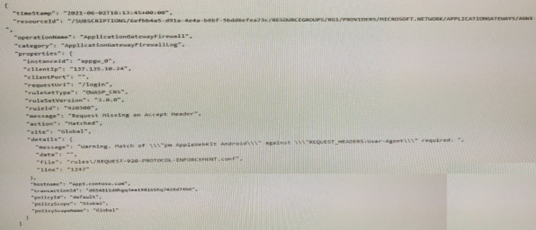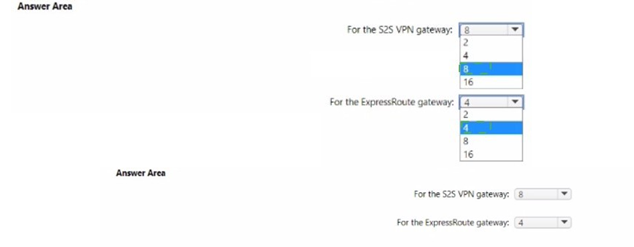Topic 3, Mix Questions
You have an Azure subscription that contains the resources shown in the following table.

Users on HP1 connect to App1 by using a URL of https://app1 .comoso.com.
You need to ensure that the IDPS on FW1 can identify security threats in the connections from HP1 to Server1.
Which two actions should you perform? Each correct answer presents part of the solution. NOTE: Each correct selection is worth one point.
A.
Enable TLS inspection for FW1.
B.
import a server certificate to KV1.
C.
Enable threat intelligence for FW1.
D.
Add an application group to HP1.
E.
Add a secured virtual network to FW1.
Enable TLS inspection for FW1.
Enable threat intelligence for FW1.
You have the Azure environment shown In the Azure Environment exhibit. (Click the Azure Environment tab.) The settings for each subnet are shown in the following table.

The Firewalls and virtual networks settings for storage1 are configured as shown in the Storage1 exhibit. (Click the Storage1 tab.) For each of the following statements, select Yes if the statement is true. Otherwise, select No. NOTE: Each correct selection is worth one point.


Your company has four branch offices and an Azure Subscription. The subscription contains an Azure VPN gateway named GW1.
The branch offices are configured as shown in the following table.

The branch office routers provide internet connectivity and Site-to-Site VPN connections to GW1.
The users in Branch1 report that they can connect to internet resources, but cannot access Azure resources.
You need to ensure that the Branch1 users can connect to the Azure Resources. The solution must meet the following requirements:
• Minimize downtime for all users.
• Minimize administrative effort.
What should you do first?
A.
Reset RTR1.
B.
Reset Connection1.
C.
Reset GW1.
D.
Recreate LNG1.
Reset Connection1.
You have an on-premises network.
You have an Azure subscription that contains a virtual network named VNet1. VNet1 contains an ExpressRoute gateway.
You need to connect VNet1 to the on-premises network by using an ExpressRoute circuit.
Which four actions should you perform in sequence? To answer, move the appropriate actions from the list of actions to the answer area and arrange them in the correct order.


You have the Azure resources shown in the following table.

You need to link VNei2 to Circuit1
What should you create in each subscription? To answer, select the appropriate options in the answer area.
NOTE: Each correct selection is worth one point.


Your company has a single on-premises datacenter in New York. The East US Azure region has a peering location in New York.
The company only has Azure resources in the East US region.
You need to implement ExpressRoute to support up to 1 Gbps. You must use only ExpressRoute Unlimited data plans. The solution must minimize costs.
Which type of ExpressRoute circuits should you create?
A.
ExpressRoute Local
B.
ExpressRoute Direct
C.
ExpressRoute Premium
D.
ExpressRoute Standard
ExpressRoute Local
You have two Azure virtual networks named Vnet1 and Vnet2 in an Azure region that has three availability zones.
You deploy 12 virtual machines to each virtual network, deploying four virtual machines per zone. The virtual machines in Vnet1 host an app named App1. The virtual machines in Vnet2 host an app named App2.
You plan to use Azure Virtual Network NAT to implement outbound connectivity for App1 and App2.
You need to identify the minimum number of subnets and Virtual Network NAT instances required to meet the following requirements:
• A failure of two zones must NOT affect the availability of either App1 or App2.
• A failure of two zones must NOT affect the outbound connectivity of either App1 or App2.
What should you identify? To answer, select the appropriate options in the answer area. NOTE: Each correct selection is worth one point.


You have an Azure application gateway named AppGW1 that provides access to the following hosts:
* www.adatum.com
* www.contoso.com
* www.fabrikam.com
AppGW1 has the listeners shown in the following table.

You create Azure Web Application Firewall (WAF) policies for AppGW1 as shown in the following table.

For each of the following statements, select Yes if the statement is true. Otherwise, select No.
NOTE: Each correct selection is worth one point.


Note: This question is part of a series of questions that present the same scenario. Each question in the series contains a unique solution that might meet the stated goals. Some question sets might have more than one correct solution, while others might not have a correct solution.
After you answer a question in this section, you will NOT be able to return to it. As a result, these questions will not appear in the review screen.
You have an Azure application gateway that has Azure Web Application Firewall (WAF) enabled.
You configure the application gateway to direct traffic to the URL of the application gateway.
You attempt to access the URL and receive an HTTP 403 error. You view the diagnostics log and discover the following error.

You need to ensure that the URL is accessible through the application gateway.
Solution: You create a WAF policy exclusion request headers that contain 137.135.10.24. Does this meet the goat?
A.
Yes
B.
No
No
You have an Azure application gateway named AGW1 that has a routing rule named Rule1. Rule 1 directs traffic for http://www.contoso.com to a backend pool named Pool1. Pool1 targets an Azure virtual machine scale set named VMSS1.
You deploy another virtual machine scale set named VMSS2.
You need to configure AGW1 to direct all traffic for http://www.adatum.com to VMSS2.
The solution must ensure that requests to http://www.contoso.com continue to be directed to Pool1.
Which three actions should you perform? Each correct answer presents part of the solution.
NOTE: Each correct selection is worth one point.
A.
Add a backend pool.
B.
Modify an HTTP setting.
C.
Add an HTTP setting.
D.
Add a listener.
E.
Add a rule.
Add a backend pool.
Add a listener.
Add a rule.
Note: This question is part of a series of questions that present the same scenario. Each question in the series contains a unique solution that might meet stated goals. Some question sets might have more than one correct solution, while others might not have a correct solution.
After you answer a question in this section, you will NOT be able to return to it. As a result, these questions will not appear in the review screen.
You have an Azure subscription that contains the following resources:
* A virtual network named Vnet1
* A subnet named Subnet1 in Vnet1
* A virtual machine named VM1 that connects to Subnet1
* Three storage accounts named storage1, storage2. and storage3
You need to ensure that VM1 can access storage1. VM1 must be prevented from accessing any other storage accounts.
Solution: You create a network security group (NSG). You configure a service tag for MicrosoftStorage and link the tag to Subnet1.
Does this meet the goal?
A.
Yes
B.
No
No
You have an Azure subscription You plan to use Azure Virtual WAN.
You need to deploy a virtual WAN hub that meets the following requirements:
• Supports 4 Gbps of Site-to-Site (S2S) VPN traffic
• Supports 8 Gbps of ExpressRoute traffic
• Minimizes costs
How many scale units should you configure? To answer select the appropriate options in the answer area.
NOTE Each correct selection is worth one point.


| Page 4 out of 16 Pages |
| Previous |